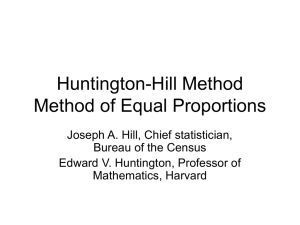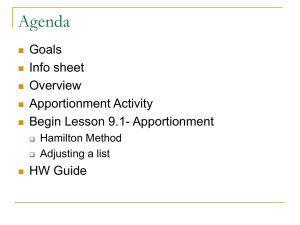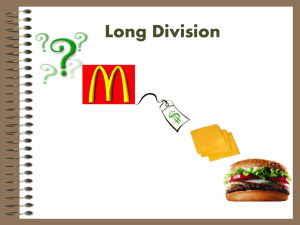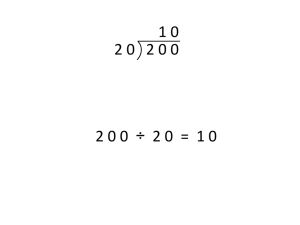Chapter 14
advertisement
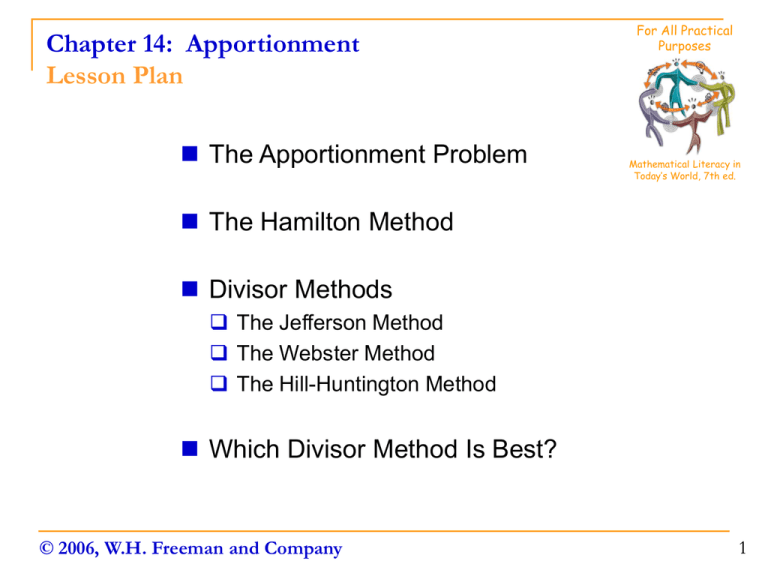
Chapter 14: Apportionment Lesson Plan The Apportionment Problem The Hamilton Method Divisor Methods The Jefferson Method The Webster Method The Hill-Huntington Method Which Divisor Method Is Best? © 2006, W.H. Freeman and Company For All Practical Purposes Mathematical Literacy in Today’s World, 7th ed. Chapter 14: Apportionment The Apportionment Problem Apportionment Problem To round a list of fractions to whole numbers in a way that their sum is maintained at its original value. The rounding procedure must not be an arbitrary one, but one that can be applied consistently. Apportionment Method – Any such rounding procedure. Example: Percentage of season’s results of a field hockey team recorded and rounded to whole numbers. The sum does not reach 100%, and this becomes an apportionment problem. The coach may want to give the extra percent to the games won—“to make it look good for the team.” This would be biased. High School Field Hockey Team: 2004–2005 Season Percentage Round Games won 18 18/23 × 100% = 78.26% 78% Games lost 4 4/23 × 100% = 17.39% 17% Games tied 1 1/23 × 100% = 4.35% 4% Games played 23 100.00% 99% Chapter 14: Apportionment The Apportionment Problem Example: Apportionment Problem In the U.S. Constitution, the seats of the House of Representatives shall be apportioned according to the state’s population. An apportionment problem occurred in 1790: The House of Representatives was to have 105 members. The country’s total population of the 15 states was 3,615,920. The average congressional district should have a population of 3,615,920 ÷ 105 = 34,437 (standard divisor). To find the fair share of House seats, we can divide each state’s population by this average, or standard divisor. Virginia = 630,560/34,437 = 18.310 and was only given 18 seats. President Washington came from Virginia. Furthermore, Virginia’s apportionment was not rounded up to 19, and he may have been biased. Hence, he did not agree this method was fair to all states. When Congress passed the apportionment proposed bill and sent it to President Washington, he vetoed it! Chapter 14: Apportionment The Apportionment Problem Standard Divisor To find the standard divisor, s: Find the total population, p, and divide it by the house size, h. s = p h The standard divisor is calculated first, then you will be able to find the fair amount of shares to give to each class or house. Quota To find the state, or class, quota, qi : Divide its population, pi, by the standard divisor, s. qi = pi s The quota is the exact share that would be allocated if a whole number were not required. Chapter 14: Apportionment The Hamilton Method The Hamilton Method An apportionment method developed by Alexander Hamilton, also called the Method of Largest Fractions. He realized that when rounding each quota to the nearest whole number, sometimes the apportionments do not add up correctly. Hamilton’s Apportionment Method: Alexander Hamilton After the quotas are calculated, round them down to the lower quota qi. Simply truncate (chop off) the decimal portion. Start with the state with the largest fraction (largest decimal portion), and round up this state’s quota to its upper quota qi. Keep assigning the states their upper quotas in order of largest fractions until the total seats in the house is reached. Originally, he wrote the congressional apportionment bill that was vetoed by President Washington in 1792, but later adopted from 1850–1900. Chapter 14: Apportionment The Hamilton Method Steps for Hamilton Method: First add up the total population of each state, p = ∑pi . Calculate the standard divisor, s = p /h (total population ÷ house). Calculate each state’s (or class) quota, qi = pi /s. Tentatively assign to each state its lower quota qi. Give the upper quota qi to the states whose quota has the largest fractional (decimal) portion until the house is filled. Apportion 5 Class Sections: 1. 2. 3. 4. 5. 1. Population ∑pi = 100. 2. Standard divisor, s s = p/h =100/5 = 20. 3. Find quotas qi = pi /s 4. List lower quotas qi . 5. Give upper quotas qi to Pre-Calc and Calc. Teach: 2 Geom, 2 Pre-Calc, 1 Calc. High School Math Teacher Apportions 5 Class Sections Course Population pi Quota qi Lower Quota qi Apportion -ment, ai Geometry 52 52/20 = 2.60 2 2 Pre-Calc 33 33/20 = 1.65 1 2 Calculus 15 15/20 = 0.75 0 1 5.00 3 5 p = 100 Chapter 14: Apportionment The Hamilton Method Alabama Paradox A paradox is a fact that seems obviously false. Discovered in 1881, a study was done on several apportionments for different house sizes, and the following was discovered: With a 299-seat house, three state quotas and apportionments were: Alabama q = 7.646 8, Illinois q = 18.640 18, Texas q = 9.640 9 With a 300-seat house, Alabama lost a seat, but the house added a seat: Alabama q = 7.671 7, Illinois q = 18.702 19, Texas q = 9.672 10 Alabama Paradox – Occurs when a state loses a seat as the result of an increase in the house size. The Population Paradox – Occurs when one state’s population increases and its apportionment decreases, while simultaneously another state’s population increases proportionally less, or decreases, and its apportionment increases. Chapter 14: Apportionment Divisor Methods Divisor Methods A divisor method of apportionment determines each state’s apportionment by dividing its population by a common divisor d and rounding the resulting quotient. Divisor methods differ in the rule used to round the quotient. Thomas Jefferson Divisor Methods: The Jefferson Method The Webster Method The Hill-Huntington Method Edward V. Huntington Daniel Webster Chapter 14: Apportionment Divisor Methods The Jefferson Method Proposed by Thomas Jefferson to replace the Hamilton Method. Instead of using the standard divisor, s, average district population, the focus is on the district with the smallest population, d. Steps for the Jefferson Method: 1. 2. 3. 4. 5. 6. 7. 8. First add up the total population, p, of all the states, ∑pi . Calculate the standard divisor, s = p /h (total population ÷ house) . Calculate each state’s (or class) quota, qi = pi /s. The tentative apportionment, ni, is the lower quota ni = pi / s = qi . This apportionment will usually not be enough to fill the house. Calculate the critical divisor for each state, di = pi /(ni + 1). The state with the largest critical divisor will get the next seat. Re-compute the apportionments ai = pi / d using this largest critical divisor, d. List the lower apportionments for ai. Continue this process until the house is filled. Chapter 14: Apportionment Divisor Methods The Webster Method A divisor method invented by Representative Daniel Webster. The Webster method is the divisor method that rounds the quota (adjusted if necessary) to the nearest whole number. Round up when the fractional part is greater than or equal to ½ . Round down when the fractional part is less than ½ . Based on rounding fraction the usual way, so that the apportionment for state i is qi , where qi is the adjusted quota for state i. The Webster method minimizes differences of representative shares between states (it does not favor the large states, as does Jefferson method). Chapter 14: Apportionment Divisor Methods Steps for the Webster Method: First add up the total population, p, of all the states ∑pi . Calculate the standard divisor, s = p /h (total population ÷ house). Calculate each state’s (or class) quota, qi = pi /s. We will call the tentative apportionment ni = qi . When the fractional part is greater than or equal to ½, round up; when the fraction part is less than ½, round down (the usual way of rounding). 5. If the sum of the tentative apportionments is enough to fill the house, we are finished, and the tentative become the actual apportionments. 6. If not…, we adjust the tentative apportionments. Adjusting the divisor: 1. 2. 3. 4. If the tentative apportionments do not fill the house, find which state has the largest critical divisor where di + = pi /(ni + ½) will receive a seat. If the tentative apportionments overfill the house, find which state has the smallest critical divisor where di− = pi /(ni − ½) will lose a seat. 7. Re-compute the apportionments ai = pi / d using this critical divisor, d. 8. Continue this process until the house is filled. Chapter 14: Apportionment Divisor Methods The Hill-Huntington Method The Hill-Huntington method is a divisor method related to the geometric mean that has been used to apportion the U.S. House of Representatives since 1940. Steps for the Hill-Huntington Method: 1. 2. 3. 4. 5. 6. 7. First, add up the total population, p, of all the states, ∑pi . Calculate the standard divisor, s = p /h (total population ÷ house). Next, calculate each state’s (or class’) quota, qi = pi / s. Find the geometric mean q* = qi qi . Round each state’s quota the Hill-Huntington way by comparing the quota to the geometric mean to obtain a first tentative apportionment. The Hill-Huntington rounding of q is equal to: qi if q < q* qi if q > q* where geometric mean q* = qi qi If the sum of the tentative apportionments is equal to the house size, the job is finished. If not, a list of critical divisors must be constructed. Chapter 14: Apportionment Divisor Methods Steps for the Hill-Huntington Method (continued): Step 7. (continued) Calculating the critical divisors, if needed … If the tentative apportionments do not fill the house, then the critical divisor for state i with population pi and tentative apportionment ni for each state is: pi di + = ni (ni + 1) The state with the largest critical divisor is first in line to receive a seat. If the tentative apportionments overfill the house, then the critical divisor for state i with population pi and tentative apportionment ni for each state is: pi di − = ni (ni − 1) The state with the smallest critical divisor is first in line to receive a seat. Chapter 14: Apportionment Which Divisor Method Is Best? Which Divisor Method is Best? (3 comparisons) To find which of the three divisor methods is the fairest, compare the apportionments produced by the methods. Remember, pi is the state’s population and ai is its apportionment. 1. One Measure of Fairness: Representative Share, ai /pi The quotient of ai ÷ pi (or ai /pi ) is called the representative share. (Represents the share of a congressional seat given to each citizen of the state.) In an ideal apportionment, every state would have the same representative share. Instead, we look for the least discrepancy. The Webster method is the fairest when comparing representative shares. 2. Another Measure of Fairness: District Population, pi /ai The quotient of pi ÷ ai (or pi /ai ) is the average population of a congressional district in the state. This method surprisingly does not agree with Webster being the fairest. Even though for state i: ai /pi = 1 ÷ pi /ai representative share = 1 / district population (The first two measures of fairness are reciprocal of each other but do not give the same results.) Chapter 14: Apportionment Which Divisor Method Is Best? Which Divisor Method is Best? (continued) 1. One Measure of Fairness: Representative Share ai /pi 2. Another Measure of Fairness: District Population pi /ai 3. Absolute and Relative Differences: (Last method of fairness) Given two positive numbers A and B, with A > B, the absolute difference is A − B and the relative difference is the quotient: (A − B)/B × 100%. For any two states, the relative difference in district population is equal to the relative difference in representative share. Therefore, an apportionment method that minimizes relative difference in representative shares will also minimize the relative difference in district population. The Hill-Huntington method gives the apportionment in which the relative differences in representative shares (or district populations) are as small as possible.
